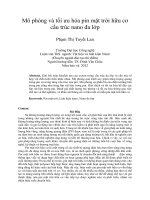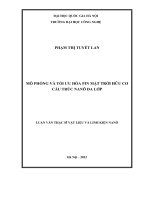Mô hình hóa, mô phỏng và tối ưu hóa các quá trình hóa họ c
Bạn đang xem bản rút gọn của tài liệu. Xem và tải ngay bản đầy đủ của tài liệu tại đây (589.08 KB, 50 trang )
Mô hình hóa, mô phỏng và tối ưu hóa
các quá trình hóa học
Modeling, simulation and optimization for chemical process
Instructor: Hoang Ngoc Ha
Email:
Bộ môn QT&TB
Curriculum/syllabi
Seminar group
Outline
• General introduction
– Structure and operation of chemical
engineering systems
– What is a chemical process?
– Motivation examples
• Part I: Process modeling
• Part II: Computer simulation
• Part III: Optimization of chemical
processes
General introduction
• Structure of chemical engineering system
(Copyright © by Prof. Paul Sides at CMU, USA)
General introduction
• Conservation laws:
– Give some balance equations such as mass balance (or the molar
number by species
), energy balance and momentum equation of the
system under consideration
• Equilibrium thermodynamics
– The extensive variables/intensive variables
– The laws of thermodynamics
• Reaction engineering
– Reaction mechanism
– The rate of a chemical reaction
• Transport processes
– How materials and energy move from one position to another (heat
conductivity, diffusion and convection…)
• Biological processes
– Transform material from one form to another (enzyme process) or
remove pollutants (environmental engineering)
General introduction
• References (complements) :
1. Sandler S. I. (1999). Chemical and Engineering
Thermodynamics. Wiley and Sons, 3rd edition.
2. H.B. Callen. Thermodynamics and an introduction to
thermostatics. JohnWiley & Sons Inc, 2nd ed. New York,
1985.
3. De Groot S. R. and P. Mazur (1962) Non-equilibrium
thermodynamics. Dover Pub. Inc., Amsterdam.
4. Vũ Bá Minh. (tập4) Kỹ thuậtphản ứng. NXB ĐHQG Tp. Hồ
Chí Minh, 2004
5. NguyễnBin, (tập 5) Các quá trình hóa học. NXB Khoa học
và Kỹ thuật, 2008
General introduction
• Conservation laws:
– Give some balance equations such as mass balance (or the molar
number by species
), energy balance and momentum equation of the
system under consideration
• Equilibrium thermodynamics
– The extensive variables/intensive variables
– The laws of thermodynamics
• Reaction engineering
– Reaction mechanism
– The rate of a chemical reaction
• Transport processes
– How materials and energy move from one position to another (heat
conductivity, diffusion and convection…)
• Biological processes
– Transform material from one form to another (enzyme process) or
remove pollutants (environmental engineering)
General introduction
Operation of a chemical engineering plant
Copyright © by T. Marlin
(Σ)
Dynamical behavior
General introduction
Oil and gas production plant
General introduction
The system may be
Isolated: There is no transfer of
mass or energy with the
environment
∑
∑
Closed: There may be transfer of
mechanical energy and heat
Open: There is mass transfer with
the environment
∑
General introduction
Gas
BA,
J
Q
.
BA
BA
υ
υ
→
Question: determinate physical volume of
the following systems?
General introduction
What is a chemical process?
Process: A set of actions performed intentionally in order to reach
some result (Longmans Dictionary of Contemporary English)
Processes that involve energy conversion, reaction, separation
and transport are called chemical processes (Prof. Erik Ydstie at
CMU, USA)
Definition: Chemical processes are a special subclass of
processes since their behavior is constrained by a range of
laws and principles which may not apply in other
circumstances (mechanical/electrical systems…)
Properties:
Highly nonlinear
Complex network
May be distributed
General introduction
Chemical processes
Thermal conductivity process
Transport (reaction) process
…
General introduction
Why we need informations about dynamical
behavior?
Research and development
Process design
Process control
Plant operation
…
Process modeling,
computer
simulation and optimization
(Σ)
Ordinary Differential Equations
(ODEs) or Partial Differential
Equations (PDEs) or
Differential and Algebraic
Equations (DAEs)
Motivation examples
Example 1: Gravity-flow tank
The higher the flow rate
¯
F ,thehigher
¯
h will be
h
F
0
F
F
F
0
= F
0
(t), h = h(t)andF = F (t)
¯
F
0
,
¯
h and
¯
F : steadystate values
Overshoot
How to understand dynamical behavior to design the
system avoiding « Overshoot »?
Motivation examples
Example 2: Heat exchanger
Thermocouple
Temperature transmitter
Temperature controller
Final control element
Motivation examples
Example 3: Typical chemical plant and control system
¾Two liquids feeds are pumped into
a reactor
¾They react to form products
¾Reactor effluent is pumped through
a preheater into a distillation
To specify the various pieces
of equipment:
•Fluid mechanics
•Heat transfer
•Chemical kinetics
•Thermodynamics and mass
transfer
Motivation examples
Example 4: Optimization of a silicon process
Thesiliconreactor
Motivation examples
Example 4: Optimization of a silicon process
Outline
General introduction
Structure and operation of chemical engineering
systems
What is a chemical process?
Motivation examples
Part I: Process modeling
Part II: Computer simulation
Part III: Optimization of chemical processes
Process modeling
Introduction
Fundamental laws
Continuity equations
Energy equation
Equations of motion
Introduction
Uses of mathematical models
Can be useful in all phases of chemical engineering, from
research and development to plant operations, and even in
business and economic studies
Research and development:
Determinating chemical kinetic mechanisms and parameters from
lab. or pilot-plant reaction data
Exploring the effects of different operating conditions
Adding in scale-up calculations…
Design
Exploring the sizing and arrangement of processing equipment
Studying the interactions of various parts…
Plant operation
Cheaper, safer and faster
Troubleshooting and processing problems…
Introduction
Scope of course
A deterministic system is a system in which no
randomness is involved in the evolution of states
of the system
∑
Random effects such as noise…
A stochastic system is non-deterministic system
Introduction
Principles of formulation
Basis
Fundamental physical and chemical laws such as laws
of conservation of mass, energy and momentum
Assumptions
Impose limitations « reasonable » on the model
Mathematical consistency of model
Number of variables equals the number of equations
(degrees of freedom)
Units of all terms in all equations are consistent
Introduction
Solution of the model equations
Initial and/or boundary conditions
Available numerical solution techniques and tools
Solutions are physically acceptable…?
Verification
The mathematical model is proving that the model
describes the “real-world” situation
Real challenge
Fundamental laws
Continuity equations
Total continuity equations (total mass balance)
EXERCISE ?
Component continuity equations (component balance)









